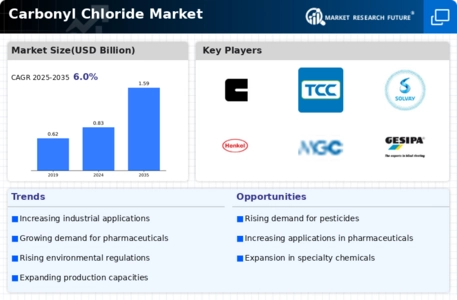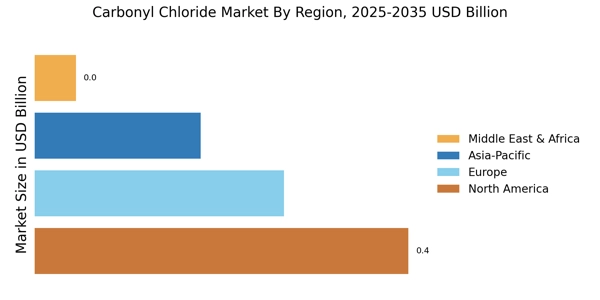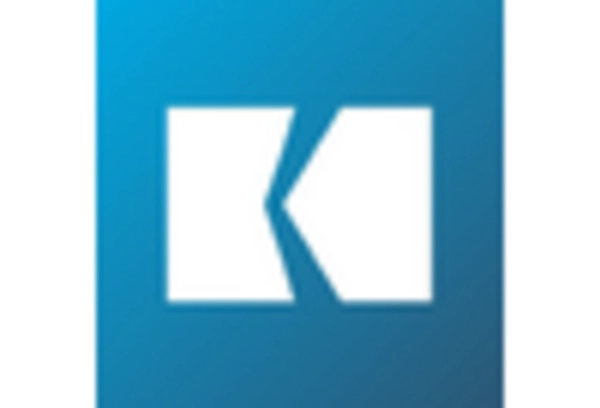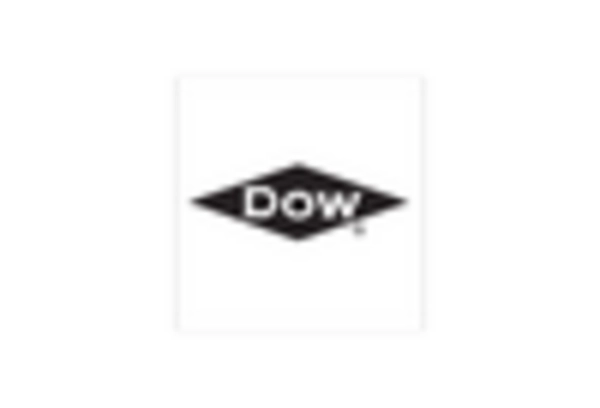Growth in Agricultural Chemicals
The Carbonyl Chloride Market is benefiting from the expanding agricultural chemicals sector, where carbonyl chloride is utilized in the production of herbicides and pesticides. The Carbonyl Chloride Market is projected to grow at a CAGR of approximately 4% over the next several years, driven by the need for increased agricultural productivity and food security. As farmers and agricultural businesses seek effective solutions to combat pests and enhance crop yields, the demand for carbonyl chloride as a precursor in agrochemical formulations is likely to rise. This trend not only supports the growth of the carbonyl chloride market but also highlights its critical role in sustainable agricultural practices, thereby reinforcing its significance within the Carbonyl Chloride Market.
Rising Demand in Chemical Synthesis
The Carbonyl Chloride Market is experiencing a notable increase in demand due to its critical role in chemical synthesis. This compound is essential for producing isocyanates, which are key intermediates in the manufacture of polyurethanes. The market for polyurethanes is projected to grow at a compound annual growth rate (CAGR) of approximately 5% over the next few years, thereby driving the need for carbonyl chloride. As industries such as automotive, construction, and furniture manufacturing expand, the demand for polyurethane products is likely to surge, consequently boosting the carbonyl chloride market. Furthermore, the versatility of carbonyl chloride in synthesizing various chemicals enhances its attractiveness to manufacturers, indicating a robust growth trajectory for the Carbonyl Chloride Market.
Regulatory Support for Chemical Safety
The Carbonyl Chloride Market is influenced by regulatory frameworks that promote chemical safety and environmental protection. Governments are increasingly implementing stringent regulations regarding the handling and use of hazardous chemicals, including carbonyl chloride. Compliance with these regulations often necessitates the adoption of safer production practices and technologies. While this may pose challenges for some manufacturers, it also creates opportunities for those who can innovate and adapt. The emphasis on safety and sustainability is likely to drive demand for carbonyl chloride produced under compliant conditions, thereby supporting the market's growth. This regulatory landscape underscores the importance of responsible practices within the Carbonyl Chloride Market.
Technological Innovations in Production
The Carbonyl Chloride Market is witnessing advancements in production technologies that enhance efficiency and reduce environmental impact. Innovations such as continuous flow reactors and improved catalytic processes are being adopted to optimize the synthesis of carbonyl chloride. These technological advancements not only increase production capacity but also lower operational costs, making carbonyl chloride more accessible to various industries. As manufacturers strive to meet growing demand while adhering to environmental regulations, the adoption of these technologies is likely to accelerate. This trend indicates a positive outlook for the Carbonyl Chloride Market, as enhanced production methods could lead to increased market penetration and competitiveness.
Expansion of Pharmaceutical Applications
The Carbonyl Chloride Market is poised for growth as the pharmaceutical sector increasingly utilizes carbonyl chloride in drug synthesis. This compound serves as a vital reagent in the production of various pharmaceuticals, including active pharmaceutical ingredients (APIs). The pharmaceutical market is anticipated to grow significantly, with a projected CAGR of around 7% in the coming years. This growth is likely to be fueled by rising healthcare expenditures and an increasing focus on innovative drug development. As pharmaceutical companies seek efficient and effective synthesis methods, the demand for carbonyl chloride is expected to rise, thereby enhancing its market position. The integration of carbonyl chloride in pharmaceutical applications underscores its importance within the Carbonyl Chloride Market.


















Leave a Comment